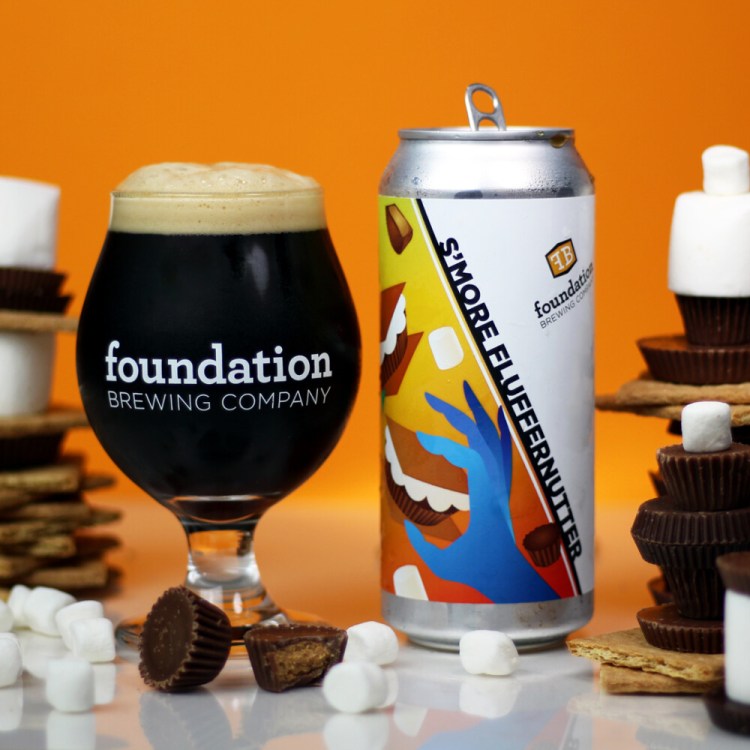High-performance athletes and breastfeeding mothers rejoice: the milk stouts are back.
If a “milk” stout sounds (speculatively) more healthy than your typical beer, well that’s by design. The style emerged in the United Kingdom in the late 19th century and gained some popularity when England’s Mackeson Brewery first brewed their version in 1907. The beer’s label featured a milk churn – an attempt to market the beer’s supposedly nutritional qualities. The style’s popularity in the U.K. peaked at the conclusion of World War II, when it became celebrated as healthy – particularly for athletes and lactating mothers. But shortly thereafter, the British government banned the use of “milk” in its advertisements: this was a period of food rationing and, after all, the beer didn’t actually contain milk.
So why, then, is it called a “milk stout”? Milk stouts are stouts made with lactose (milk sugar), which is added to the boiling wort before fermentation. Lactose is unfermentable by brewing yeast, and so it lingers in the finished beer, contributing body, sweetness, and a creamy mouthfeel. This sweet creaminess is joined to roasted malts that add coffee and chocolate flavors to the mix.
Austin Street’s Six Grain, which has returned for the looming winter, is a brilliant expression of the style. Befitting its name, this 6.4 percent stout has a roasted grain nose. The mouthfeel is creamy, but not stodgy. A complex layering of flavors – coffee, cream, and chocolate – work their way around each sip, with a roasty, semi-sweet finish.
Six Grain is one of the veteran local milk stouts that have become staples of the Portland beer scene over the last half decade or so – alongside Mast Landing’s Gunner’s Daughter, Fore River’s John Henry, and Bissell Brothers’ Revival. These regular rotation players have been joined by some newcomers of late – milk stouts notable for their embrace of other sugary ingredients.
Foundation’s S’More Fluffernutter – a recently released 6.5 percent milk stout – is brewed with graham crackers in the mash, then aged with cocoa, vanilla beans, marshmallow and peanut butter flavor. Dark brown in color, it bursts with the aromas of those additions. It’s lighter bodied than some of the other milk stouts you might come across, a little less roasty, and sweet indeed. According to the brewery, this “liquid candy” is inspired by s’mores made with peanut butter cups (or, if you prefer, a fluffernutter sandwich accented with chocolate). For those with a sweet tooth, but looking for something on the lighter side of most candied stouts, this beer’s for you.
How do brewers reckon with this cornucopia of additional ingredients? According to owner John Bonney, one must “think critically about how you want to handle each one.” For S’More Fluffernutter, it is particularly important to determine how long it will take ingredients added to the fermentation tank to impart new flavors.
“There are lots of different approaches,” Bonney says. “We figure it out mostly through trial and error and talking with friends, seeing what they have worked out.” The “collaborative nature of craft beer” enables this sort of cooperative knowledge-sharing, he notes. But in the end, “each brewer has to think it through and figure out the path they think will work best for them, then go for it, and see what happens.”
Pieces, from Definitive Brewing, is another new milk stout appropriate to the Halloween season – the eponymous “pieces” being a reference to Reeses’ candies. It’s nearly black in the glass, with a roastiness verging on burnt matched with peanut butter and chocolate. The brewery pitches it to aficionados of “peanut butter fudge, Choco Tacos, and chocolate PB cereal milk.” While sweet, that roasty bitterness provides some balance. It’s more robust than S’More Fluffernutter, for sure, and yet at a relatively manageable 7.2 percent, Pieces is a nice alternative to some of the boozier pastry stouts out there.

Gunner’s Daughter became a fast favorite at Mast Landing Brewing. Photo courtesy of Mast Landing Brewing
Of course, any local peanut butter milk stout will be rubbing shoulders with Mast Landing’s Gunner’s Daughter – a beer with a curious history (and name). Its status as the brewery’s flagship was hardly preordained. Mike Capen, a business partner of two of the brewery’s founders, Ian Dorsey and Neil Frederick, returned from a trip to California with a trove of unique beers he encountered along the way. One of the fruits of this cross-continental beer run was a particularly impressive peanut butter stout. The brewers wanted to recreate its flavor profile, but without using any peanut butter or nuts. After experimentation with the malt bill and some other non-nut flavorings (like vanilla), Gunner’s Daughter was born. Gene Buonaccorsi, Mast Landing’s director of marketing, remembers, “Once it hit the draft lines in the tasting room the feedback was immediate. Our team loved the way the beer was fitting into the lineup, and the public responded to it so well that there was no question about keeping it around.”
Undoubtedly, drinking a Gunner’s Daughter is preferable to “marrying” one. Its name references the corporal punishment meted out on naval vessels, whereby seamen were lashed face down upon a cannon (to “marry” it) before being whipped.
The current harvest of milk stouts are each far better than a beating, though ample experimentation suggests that, sadly, they don’t enhance one’s athleticism.
Ben Lisle is an assistant professor of American Studies at Colby College. He lives among the breweries in Portland’s East Bayside, where he writes about cultural history, urban geography, and craft beer culture. Reach him on Twitter at @bdlisle.
Send questions/comments to the editors.


